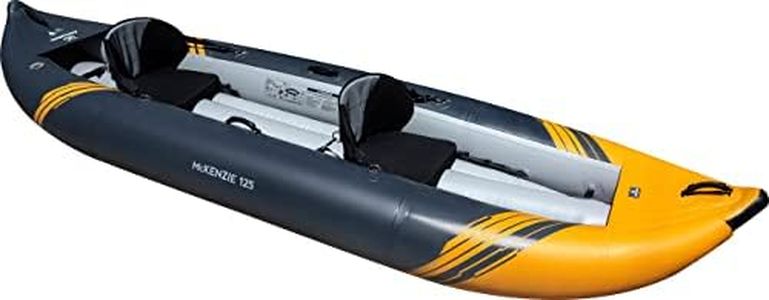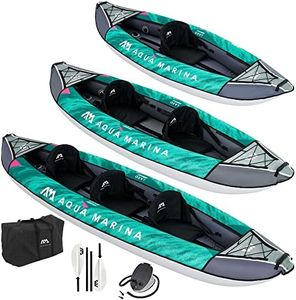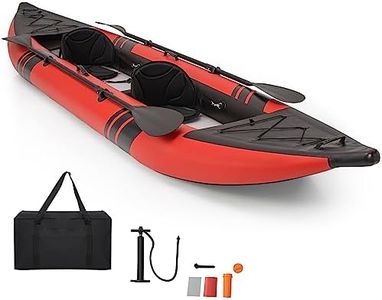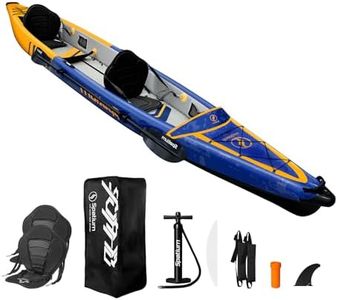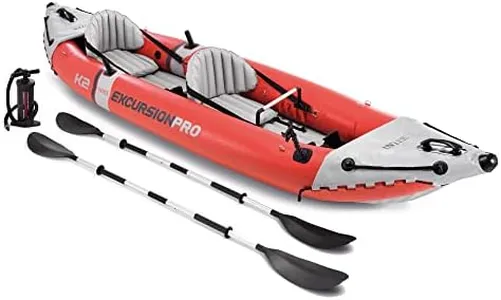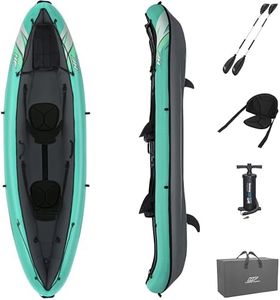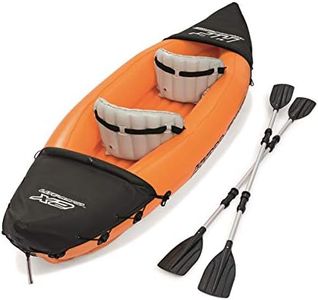We Use CookiesWe use cookies to enhance the security, performance,
functionality and for analytical and promotional activities. By continuing to browse this site you
are agreeing to our privacy policy
10 Best Tandem Kayaks
From leading brands and best sellers available on the web.Buying Guide for the Best Tandem Kayaks
Choosing the right tandem kayak can make your adventures on the water enjoyable and safe. It's important to consider how and where you plan to use the kayak, who will be using it with you, and what kind of experience you're looking for. Pay attention to the key features and specifications, as they determine how the kayak will perform in different conditions and for different types of users. By understanding what each specification means and matching it to your needs, you'll be able to select a tandem kayak that provides comfort, stability, and the experience you want.LengthLength refers to the measurement from the tip of the bow to the stern. Longer tandem kayaks are generally faster and track straighter, making them better for covering long distances or paddling in open water. Shorter ones are easier to maneuver, transport, and store, which is great for navigating tight rivers or if you have limited storage space. If you plan to do longer trips or paddling on lakes and coastal waters, a longer kayak is usually a better fit. For shorter outings or river paddling with lots of curves, a shorter kayak might be the right choice.
WidthWidth, or beam, affects stability and speed. Wider tandem kayaks tend to be more stable, which is great for beginners, families, or anyone who values a steady ride, especially in calmer waters. However, they are also usually slower and can be harder to paddle over long distances. Narrower kayaks move more efficiently and suit experienced paddlers or those looking for speed, typically in open water. Pick a width that matches your confidence level and typical paddling conditions—go wider for stability, narrower for performance.
Weight CapacityWeight capacity tells you the maximum combined weight (including paddlers and gear) the kayak can safely carry. Exceeding this limit can make the kayak sit low in the water, affecting performance and safety. When navigating this spec, add up the expected weight of both paddlers and the typical gear you'll bring along, including coolers or fishing equipment. Choose a kayak with a weight limit that is comfortably above your total expected load to ensure a safe and enjoyable ride.
Type (Sit-on-top vs. Sit-inside)There are two main types of tandem kayaks: sit-on-top and sit-inside. Sit-on-top kayaks are easy to get in and out of, self-draining, and are great for warm-weather paddling or activities where you might get wet, like fishing or swimming stops. Sit-inside kayaks give you more protection from splashes and wind, making them better for cooler environments or longer excursions. Your choice should be guided by where you'll paddle and the kind of comfort and exposure you're okay with.
Hull ShapeHull shape affects the way a tandem kayak behaves on the water. Flat hulls provide more initial stability, making them suitable for beginners and calm water. V-shaped hulls are less stable initially but track straighter and are faster, favored for open or rougher water. Rounded hulls offer a good balance for mixed uses. Consider your skill level and paddling environment when evaluating hull shape—for stability, go flatter; for speed and efficiency, lean toward a V-shape.
Seat Comfort and AdjustabilitySeat comfort is crucial, especially for longer trips. Adjustable or padded seats make a big difference in how enjoyable your paddling experience is. When reviewing this, consider how long you plan to be in the kayak at one time and if you or your paddling partner have any back issues or comfort needs. The ability to adjust the seat position can also help balance the kayak and accommodate different-sized paddlers, so pick a kayak that matches your comfort preferences.
Storage OptionsStorage options refer to the space and compartments provided for carrying gear. Some tandem kayaks offer sealed hatches or bungee cord areas for securing dry bags, coolers, or other gear. If you plan on longer trips or carrying equipment for activities like fishing or camping, you'll need more and better storage areas. For shorter or casual paddles, minimal storage may suffice. Assess what you'll typically bring and choose a kayak that can comfortably hold your gear.
Weight of the KayakThe kayak's weight impacts how easy it is to carry, load onto a car, and maneuver off the water. Heavier kayaks tend to be more stable and durable but can be challenging to transport, especially if two people need to carry it a long distance. Lighter kayaks are easier to move and manage but might sacrifice some durability. Consider who will be helping with transport and how far you’ll need to carry it when selecting a weight that works for you.



